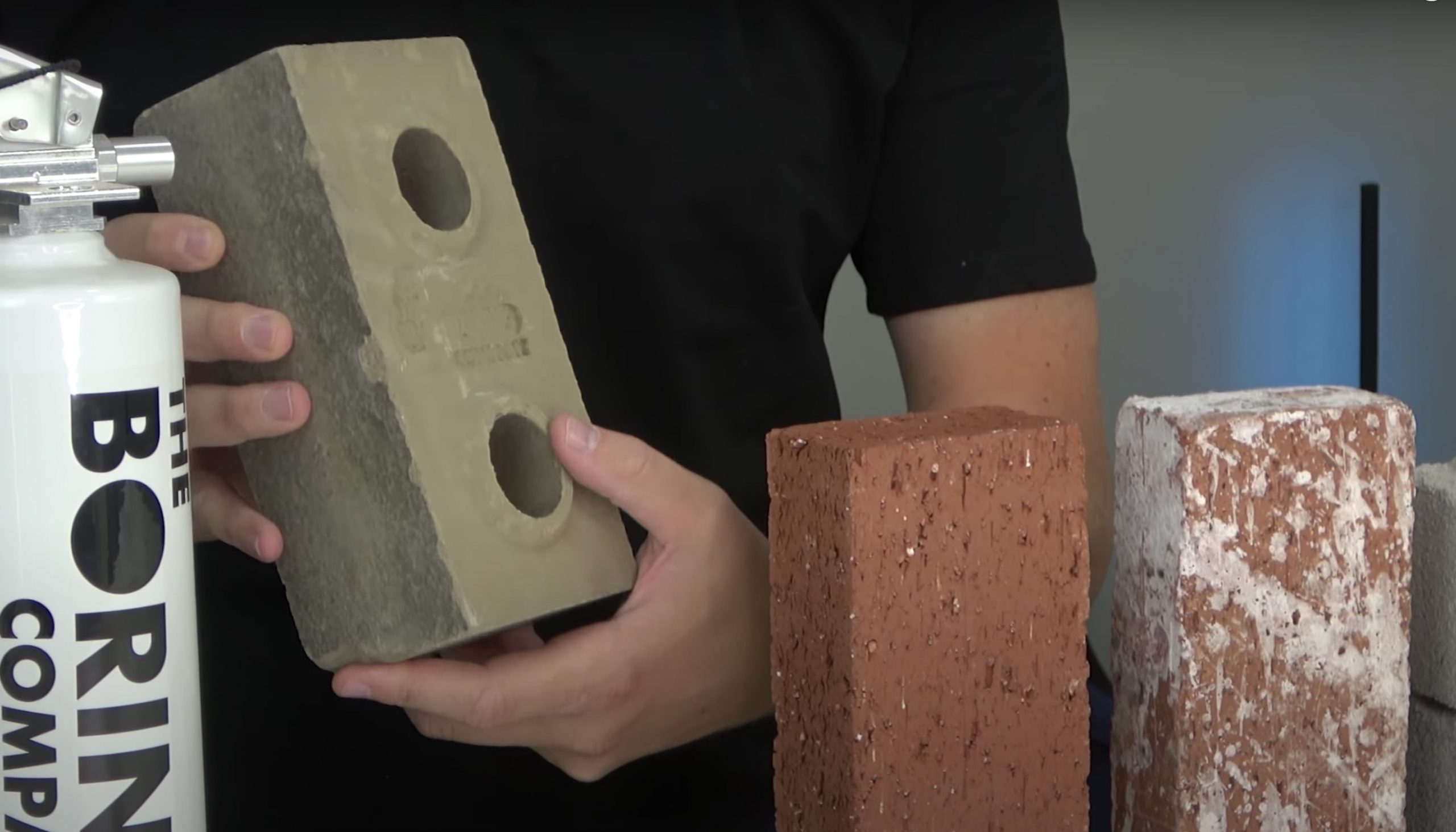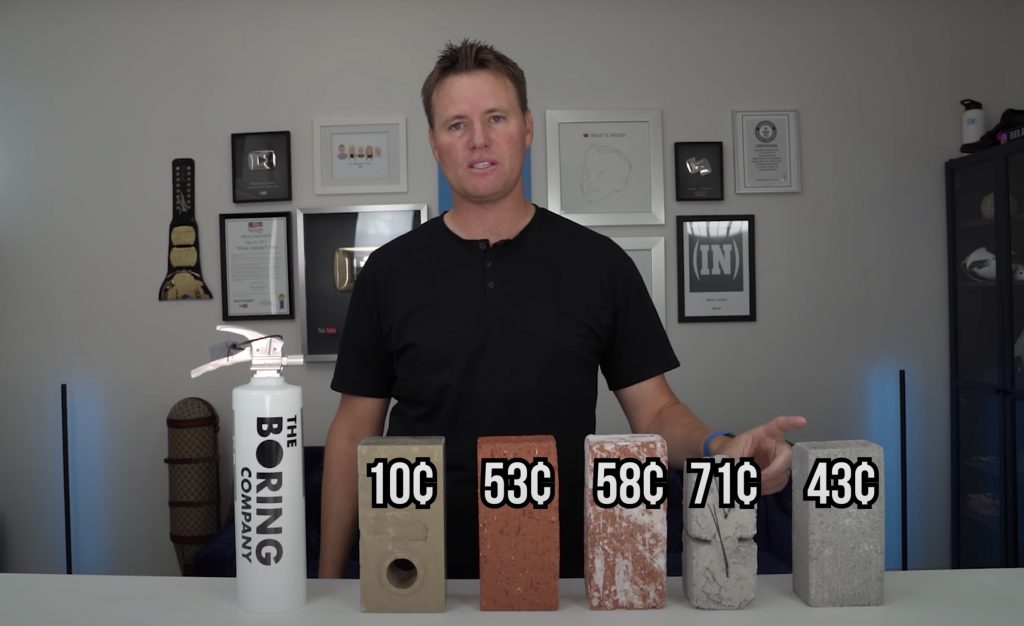

News
Tesla owner scores Elon Musk’s “V1” Boring Brick to perform drop test comparison
A Tesla owner recently acquired a rare “V1” sample of Elon Musk’s Boring Company brick for a durability test. Dan Markham from YouTube’s What’s Inside channel was able to get his hands on two Boring bricks and had some fun performing a drop test to compare its durability with potential competitors in the market.
Markham managed to get a hold of two Boring Bricks from the first batch of 500 “V1” pieces, thanks to a Boring Co. employee. The Tesla and SpaceX CEO has talked about inexpensive bricks made out of tunneling rock since 2018, and in true Elon Musk fashion, he called them Boring Bricks. Musk had stated that the Boring Bricks would cost 10¢ a piece, significantly lower than bricks on the market.
Besides the Boring Brick’s material and affordable price, another intriguing feature about it would be its durability. When Musk introduced the Boring Brick, he emphasized its strength. “[Boring Bricks are] Rated for California seismic loads, so super strong, but bored in the middle, like an aircraft wing spar, so not heavy,” Musk said later in a tweet.
Markham wanted to put Musk’s words to the test and compared his Boring Bricks with four traditional alternatives. He bought an average red clay brick for 53¢, a used clay brick for 58¢, a cinder block brick reinforced with steel for 71¢, and a normal cinder block brick for 43¢.

For his durability test, Markham dropped each brick from different heights until they broke into pieces. For the first test, he dropped them from chest-level and the Boring Brick passed with no problem. The 71¢ cinder block brick reinforced with steel passed without any scratches, and the 53¢ red clay brick survived the first test as well with a slight chip in the corner.
Sadly, the 58¢ clay brick and 43¢ cinder block were eliminated in the first round after both broke in two.
For the second test, Markem went up a flight of stairs and dropped the bricks from about 10 feet above the ground. The remaining bricks all passed the second round relatively unscathed, except for a small chip on the corner of the red clay brick and a tiny one on the Boring Brick.
In the third test, the Boring Brick proved its durability once more, surviving a fall from about 12-14 feet above the ground with just another slight chip. By this time, the only other brick that survived Markham’s durability test was the cinder block brick reinforced with steel, which cost over 7x the price of the Boring Brick.
The What’s Inside? host’s test was undoubtedly fun and did demonstrate the durability of the Boring Brick at some level. However, the durability of bricks is usually tested through compression and there are other factors to consider when judging a brick’s quality.
Nevertheless, Markham’s video managed to show that the Boring Brick is a viable product and could be another potentially revolutionary idea from Musk. At its price point, Boring Bricks could change the construction and housing market. Markham paid a little extra for his Boring Bricks but didn’t seem to mind since they were commemorative pieces. He paid $200 for each Boring Brick and gave one of them to a friend.
Elon described Boring Bricks as “lifesize LEGO-like interlocking bricks” in the past. Based on the bricks that Markham acquired, it appears that Musk is sticking to his plan. The Boring Brick had two holes in the center reminiscent of Lego bricks, with “The Boring Company” written in the middle. These should allow for easy buildouts for construction projects, as the bricks are optimized to be laid with relatively little effort.
Watch Dan Markham’s Boring Brick durability test in the video below.

News
Tesla starts showing how FSD will change lives in Europe
Local officials tested the system on narrow country roads and were impressed by FSD’s smooth, human-like driving, with some calling the service a game-changer for everyday life in areas that are far from urban centers.

Tesla has launched Europe’s first public shuttle service using Full Self-Driving (Supervised) in the rural Eifelkreis Bitburg-Prüm region of Germany, demonstrating how the technology can restore independence and mobility for people who struggle with limited transport options.
Local officials tested the system on narrow country roads and were impressed by FSD’s smooth, human-like driving, with some calling the service a game-changer for everyday life in areas that are far from urban centers.
Officials see real impact on rural residents
Arzfeld Mayor Johannes Kuhl and District Administrator Andreas Kruppert personally tested the Tesla shuttle service. This allowed them to see just how well FSD navigated winding lanes and rural roads confidently. Kruppert said, “Autonomous driving sounds like science fiction to many, but we simply see here that it works totally well in rural regions too.” Kuhl, for his part, also noted that FSD “feels like a very experienced driver.”
The pilot complements the area’s “Citizen Bus” program, which provides on-demand rides for elderly residents who can no longer drive themselves. Tesla Europe shared a video of a demonstration of the service, highlighting how FSD gives people their freedom back, even in places where public transport is not as prevalent.
What the Ministry for Economic Affairs and Transport says
Rhineland-Palatinate’s Minister Daniela Schmitt supported the project, praising the collaboration that made this “first of its kind in Europe” possible. As per the ministry, the rural rollout for the service shows FSD’s potential beyond major cities, and it delivers tangible benefits like grocery runs, doctor visits, and social connections for isolated residents.
“Reliable and flexible mobility is especially vital in rural areas. With the launch of a shuttle service using self-driving vehicles (FSD supervised) by Tesla in the Eifelkreis Bitburg-Prüm, an innovative pilot project is now getting underway that complements local community bus services. It is the first project of its kind in Europe.
“The result is a real gain for rural mobility: greater accessibility, more flexibility and tangible benefits for everyday life. A strong signal for innovation, cooperation and future-oriented mobility beyond urban centers,” the ministry wrote in a LinkedIn post.
News
Tesla China quietly posts Robotaxi-related job listing
Tesla China is currently seeking a Low Voltage Electrical Engineer to work on circuit board design for the company’s autonomous vehicles.

Tesla has posted a new job listing in Shanghai explicitly tied to its Robotaxi program, fueling speculation that the company is preparing to launch its dedicated autonomous ride-hailing service in China.
As noted in the listing, Tesla China is currently seeking a Low Voltage Electrical Engineer to work on circuit board design for the company’s autonomous vehicles.
Robotaxi-specific role
The listing, which was shared on social media platform X by industry watcher @tslaming, suggested that Tesla China is looking to fill the role urgently. The job listing itself specifically mentions that the person hired for the role will be working on the Low Voltage Hardware team, which would design the circuit boards that would serve as the nervous system of the Robotaxi.
Key tasks for the role, as indicated in the job listing, include collaboration with PCB layout, firmware, mechanical, program management, and validation teams, among other responsibilities. The role is based in Shanghai.
China Robotaxi launch
China represents a massive potential market for robotaxis, with its dense urban centers and supportive policies in select cities. Tesla has limited permission to roll out FSD in the country, though despite this, its vehicles have been hailed as among the best in the market when it comes to autonomous features. So far, at least, it appears that China supports Tesla’s FSD and Robotaxi rollout.
This was hinted at in November, when Tesla brought the Cybercab to the 8th China International Import Expo (CIIE) in Shanghai, marking the first time that the autonomous two-seater was brought to the Asia-Pacific region. The vehicle, despite not having a release date in China, received a significant amount of interest among the event’s attendees.
Elon Musk
Elon Musk and Tesla AI Director share insights after empty driver seat Robotaxi rides
The executives’ unoccupied tests hint at the rapid progress of Tesla’s unsupervised Robotaxi efforts.

Tesla CEO Elon Musk and AI Director Ashok Elluswamy celebrated Christmas Eve by sharing personal experiences with Robotaxi vehicles that had no safety monitor or occupant in the driver’s seat. Musk described the system’s “perfect driving” around Austin, while Elluswamy posted video from the back seat, calling it “an amazing experience.”
The executives’ unoccupied tests hint at the rapid progress of Tesla’s unsupervised Robotaxi efforts.
Elon and Ashok’s firsthand Robotaxi insights
Prior to Musk and the Tesla AI Director’s posts, sightings of unmanned Teslas navigating public roads were widely shared on social media. One such vehicle was spotted in Austin, Texas, which Elon Musk acknowleged by stating that “Testing is underway with no occupants in the car.”
Based on his Christmas Eve post, Musk seemed to have tested an unmanned Tesla himself. “A Tesla with no safety monitor in the car and me sitting in the passenger seat took me all around Austin on Sunday with perfect driving,” Musk wrote in his post.
Elluswamy responded with a 2-minute video showing himself in the rear of an unmanned Tesla. The video featured the vehicle’s empty front seats, as well as its smooth handling through real-world traffic. He captioned his video with the words, “It’s an amazing experience!”
Towards Unsupervised operations
During an xAI Hackathon earlier this month, Elon Musk mentioned that Tesla owed be removing Safety Monitors from its Robotaxis in Austin in just three weeks. “Unsupervised is pretty much solved at this point. So there will be Tesla Robotaxis operating in Austin with no one in them. Not even anyone in the passenger seat in about three weeks,” he said. Musk echoed similar estimates at the 2025 Annual Shareholder Meeting and the Q3 2025 earnings call.
Considering the insights that were posted Musk and Elluswamy, it does appear that Tesla is working hard towards operating its Robotaxis with no safety monitors. This is quite impressive considering that the service was launched just earlier this year.








